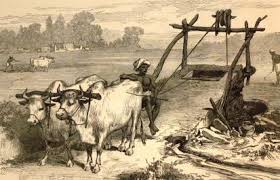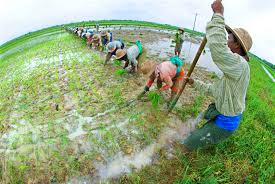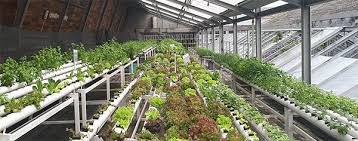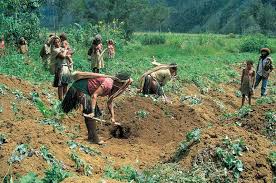Historical Development of Agriculture has been crucial to the growth of human civilization, enabling the transition from nomadic hunter-gatherer societies to settled farming communities. Its origins date back over 10,000 years, with the earliest evidence found in the Fertile Crescent, a region encompassing parts of modern-day Iraq, Syria, and Turkey.
This area was home to the domestication of early crops like wheat, barley, and lentils, along with animals such as sheep and goats. These early agricultural activities marked the beginning of the Neolithic Revolution, a period when humans started actively shaping their environment to support their food needs, laying the foundation for future agricultural advancements.
As agriculture spread, various regions developed distinct practices. In Asia, rice farming emerged in the fertile valleys of China, while maize, beans, and squash became staple crops in the Americas. Initially, early farmers used simple tools such as digging sticks and stone implements for planting and harvesting.
Over time, they began selective breeding to improve crop yield and resilience, creating the basis for genetic advancements in agriculture that continue today.
With the growth of societies, agricultural methods became more sophisticated. Ancient Egypt and Mesopotamia developed irrigation systems, allowing for consistent farming in arid areas, which supported larger, more stable populations.
In medieval Europe, innovations like the three-field crop rotation system and the heavy plow increased productivity, fostering the rise of towns and trade networks. The Industrial Revolution later introduced mechanized farming equipment, making agriculture more efficient and scalable.
Today, agricultural practices continue to evolve with technological advancements and sustainable approaches. Understanding its historical development helps us appreciate how agriculture has shaped human progress and continues to influence modern societies worldwide.
Early Agricultural Practices and Techniques
Early agricultural practices relied heavily on trial and error, with communities learning which plants could be grown and which animals could be domesticated. Key practices and techniques during this time included:
1. Seed Selection: Ancient people began selecting and planting seeds from plants that produced desirable traits, such as higher yields or better taste, laying the foundation for modern crop breeding.
2. Basic Irrigation: Early agriculturalists diverted water from rivers to fields using simple canals, ensuring a more consistent water supply for crops, especially in dry seasons.
3. Crop Rotation: To maintain soil fertility, some early farmers practiced crop rotation, growing different crops in the same area across seasons to prevent soil depletion.
The Rise of Ancient Agricultural Civilizations

Agriculture played a fundamental role in the rise of some of the world’s first civilizations. These civilizations, which flourished between 3000 and 2000 BCE, owed much of their success to advancements in farming. Key examples include:
1. Mesopotamia: Known as the “Cradle of Civilization,” Mesopotamia’s fertile soil, due to the Tigris and Euphrates rivers, allowed for abundant crop production, supporting large populations and leading to urban development.
2. Ancient Egypt: The Nile River’s predictable flooding deposited nutrient-rich silt on the banks, creating ideal conditions for agriculture. This enabled Ancient Egyptians to grow staple crops like wheat and barley.
3. Indus Valley Civilization: Advanced irrigation and water management systems helped the Indus Valley people cultivate crops, supporting a thriving civilization in what is now Pakistan and northwest India.
4. Ancient China: In the Yellow River Basin, ancient Chinese farmers grew rice and millet, developing sophisticated farming techniques that sustained a large and growing population.
Agricultural Innovations in the Middle Ages
During the Middle Ages, agriculture saw significant innovations, improving food production and shaping society. These innovations included:
1. The Three-Field System: By rotating crops among three fields—one for spring crops, one for autumn crops, and one left fallow—farmers could increase their annual yields and reduce soil exhaustion.
2. Heavy Plow: The development of the heavy plow allowed farmers to cultivate the dense, clay-rich soils of Northern Europe more efficiently, leading to expanded farmland and improved productivity.
3. Horse Collar and Horseshoe: These inventions enabled horses to be used more effectively in farming, as they could pull plows and carts with greater strength and speed than oxen, improving agricultural productivity.
4. Windmills and Watermills: The use of wind and water to grind grain, saw wood, and perform other tasks reduced labor demands and increased efficiency in agricultural communities.
The Agricultural Revolution and Its Impact
The Agricultural Revolution, which began in the 18th century in Britain, marked a period of rapid transformation in farming practices, largely driven by technological advancements and scientific discoveries. Key developments of this period include:
1. Crop Rotation Systems: Farmers adopted complex crop rotation systems, such as the Norfolk four-course system, which rotated wheat, turnips, barley, and clover, improving soil fertility and increasing yields.
2. Mechanization: The invention of farming equipment, like the seed drill by Jethro Tull, made planting more efficient, while the mechanization of tasks such as harvesting helped scale up food production.
3. Selective Breeding: Farmers began to practice selective breeding, improving livestock for higher productivity, such as cattle that produced more milk or sheep with finer wool.
4. Enclosure Movement: In Britain, the Enclosure Movement consolidated small plots of land into larger, more productive farms, transforming the rural landscape and increasing agricultural efficiency.
Read Also: Tangerine and Mandarin Flowers: Economic Importance, Uses and By-Products
The Impact of the Agricultural Revolution

The Agricultural Revolution had profound effects on society, laying the foundation for modern agricultural practices and fueling population growth. Its impacts included:
1. Increased Food Supply: Enhanced productivity enabled a more reliable and abundant food supply, contributing to better nutrition and supporting larger populations.
2. Urbanization: As agriculture became more efficient, fewer people were needed to work the land. This shift led to rural populations migrating to cities, fueling the growth of urban centers and the Industrial Revolution.
3. Economic Transformation: With surplus production, agriculture became a commercial enterprise, encouraging trade, and shaping economic systems.
4. Environmental Changes: The intensification of agriculture led to deforestation, soil depletion, and other environmental impacts that have had long-lasting effects on ecosystems.
The evolution of agriculture has continually reshaped human civilization, providing the resources needed to support large populations, driving technological advancements, and influencing social and economic development. Understanding these historical agricultural transformations offers insight into current practices and the ongoing challenge of feeding a growing global population sustainably.
Read Also: List of Diseases Ruminant Animals (Livestock) Get from Feeds and Water
Technological Advancements in Contemporary Agriculture

Agriculture today relies heavily on advanced technologies that increase productivity, efficiency, and sustainability. Key advancements include:
1. Mechanization: Tractors, combines, and other machinery have replaced manual labor for plowing, planting, and harvesting, significantly speeding up production and reducing the labor required.
2. Genetic Engineering: Genetically modified crops have been developed to resist pests, tolerate herbicides, and improve nutritional content, enhancing yield and reducing reliance on chemical inputs.
3. Precision Agriculture: Technologies like GPS, remote sensing, and drones enable farmers to monitor crop health, manage resources efficiently, and apply inputs (e.g., water, fertilizers) only where needed, minimizing waste and maximizing productivity.
4. Irrigation Innovations: Modern irrigation systems, such as drip and sprinkler systems, provide precise water delivery, improving water-use efficiency and supporting crop production in arid regions.
5. Agricultural Biotechnology: Developments in biotechnology have led to improved crop varieties and animal breeds, increased disease resistance, and more efficient nutrient absorption, contributing to higher yields and more resilient agricultural systems.
The Role of Agriculture in Globalization
Agriculture has become a major component of the global economy, with countries trading agricultural products across borders. This interdependence has led to:
1. Expanded Trade Networks: Countries export and import agricultural products, making food and other agricultural goods available worldwide. This has led to global markets for commodities like coffee, sugar, and grains.
2. Economic Growth and Employment: Agriculture supports economies, particularly in developing nations, by creating jobs and generating income through exports, which contribute to national GDP.
3. Technological and Knowledge Exchange: Globalization has facilitated the exchange of farming techniques, research, and technology, allowing countries to adopt best practices and improve productivity.
4. Cultural Exchange: The global trade of agricultural products introduces new foods and flavors, fostering cultural exchange and diversification of diets across countries.
Environmental Impacts and Sustainable Agricultural Practices
While modern agriculture has improved productivity, it has also raised environmental concerns. Sustainable practices are being adopted to address these challenges and ensure long-term productivity. Key aspects include:
1. Soil Health Management: Practices like crop rotation, cover cropping, and reduced tillage improve soil structure, enhance fertility, and reduce erosion, promoting long-term soil health.
2. Water Conservation: Efficient irrigation systems and water management practices help conserve water resources, which is essential in areas facing water scarcity.
3. Reduced Chemical Use: Integrated Pest Management (IPM) and organic farming reduce the reliance on synthetic pesticides and fertilizers, minimizing the impact on surrounding ecosystems.
4. Carbon Sequestration: Agricultural practices, such as agroforestry and conservation tillage, help sequester carbon in the soil, contributing to climate change mitigation.
5. Biodiversity Conservation: Maintaining biodiversity through polyculture, buffer strips, and preservation of natural habitats supports ecosystem health and resilience.
Modern agriculture continues to evolve with innovations that balance productivity with environmental stewardship. The focus on sustainable practices is crucial to meeting the food demands of a growing population while safeguarding natural resources and promoting ecological health.
Do you have any questions, suggestions, or contributions? If so, please feel free to use the comment box below to share your thoughts. We also encourage you to kindly share this information with others who might benefit from it. Since we can’t reach everyone at once, we truly appreciate your help in spreading the word. Thank you so much for your support and for sharing!
Read Also: Benefits of Automated Farming

